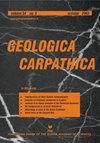The late Badenian–Sarmatian (Serravallian) environmental transition calibrated by sequence stratigraphy (eastern Danube Basin, Central Paratethys)
IF 1.5
4区 地球科学
Q4 GEOSCIENCES, MULTIDISCIPLINARY
引用次数: 7
Abstract
The late Badenian and Sarmatian (Serravallian) evolution of depositional environments in the Danube Basin (Želiezovce Depression) has never been fully explored. Here, we clarify the paleoenvironmental changes which took place in this area during the late Badenian and Sarmatian on the basis of sedimentological, petrographic, biostratigraphic and paleobotanical analyses performed at multiple sections. The combination of these methods with sequence stratigraphy allowed us to divide the sedimentary record into three main intervals: 1) the transgressive late Badenian rocky shore deposits (transgressive and/or highstand system tract), followed by a gap in the stratigraphic record (that can approximately coincide with the latest Badenian falling stage system tract). 2) Earliest Sarmatian terrestrial deposits connected with the beginning of the Sarmatian transgression (synchronous with the lowstand system tract). 3) The early Sarmatian deltaic environment influenced by tidal processes associated with the highstand system tract. The fossil leaf association indicates a climatic turnover from subtropical to temperate conditions between the earliest (lowstand system tract) and the early Sarmatian (highstand system tract). Sediments of the late Sarmatian (falling stage system tract) were not deposited or were later eroded. However, they may be present in the neighbouring depressions, which tectonically opened during the late Sarmatian. The Badenian–Sarmatian boundary in the Želiezovce Depression is developed in transgressive shallow marine to terrestrial volcano-sediments as is typical for this boundary in most other Paratethys depocentres.通过层序地层学校准的晚期Badenian-Sarmatian(Serravallian)环境转换(多瑙河盆地东部,Paratethys中部)
多瑙河盆地(日埃列佐夫凹陷)晚巴登尼亚和萨尔马提亚(塞拉瓦利安)沉积环境的演化从未得到充分探索。在这里,我们根据多个剖面进行的沉积学、岩石学、生物地层学和古植物学分析,阐明了该地区在巴登尼亚晚期和萨尔马提亚期发生的古环境变化。将这些方法与层序地层学相结合,使我们能够将沉积记录划分为三个主要层段:1)海侵晚期巴登尼亚岩岸沉积(海侵和/或高位系统域),然后是地层记录中的一个间隙(可以与最新的巴登尼亚下降阶段系统域大致重合)。2) 与萨尔马提亚海侵开始有关的最早萨尔马提亚陆生矿床(与低位系统域同步)。3) 早期萨尔马提亚三角洲环境受到与高位系统域相关的潮汐过程的影响。化石叶组合表明,在最早的(低位系统域)和早的萨尔马提亚(高位系统域)之间,气候从亚热带转变为温带。萨尔马提亚晚期的沉积物(下降期系统域)没有沉积或后来被侵蚀。然而,它们可能存在于邻近的凹陷中,这些凹陷在萨尔马提亚晚期构造开放。日埃列佐夫策凹陷的Badenian–Sarmatian边界发育于海侵浅海至陆生火山沉积物中,这是大多数其他Paratethys沉积中心的典型边界。
本文章由计算机程序翻译,如有差异,请以英文原文为准。
求助全文
约1分钟内获得全文
求助全文
来源期刊

Geologica Carpathica
地学-地球科学综合
CiteScore
2.40
自引率
23.10%
发文量
26
审稿时长
>12 weeks
期刊介绍:
GEOLOGICA CARPATHICA covers a wide spectrum of geological disciplines including geodynamics, tectonics and structural geology, volcanology, stratigraphy, geochronology and isotopic geology, karstology, geochemistry, mineralogy, petrology, lithology and sedimentology, paleogeography, paleoecology, paleobiology and paleontology, paleomagnetism, magnetostratigraphy and other branches of applied geophysics, economic and environmental geology, experimental and theoretical geoscientific studies. Geologica Carpathica , with its 60 year old tradition, presents high-quality research papers devoted to all aspects not only of the Alpine-Carpathian-Balkanian geoscience but also with adjacent regions originated from the Mediterranean Tethys and its continental foreland. Geologica Carpathica is an Official Journal of the Carpathian-Balkan Geological Association.
 求助内容:
求助内容: 应助结果提醒方式:
应助结果提醒方式:


